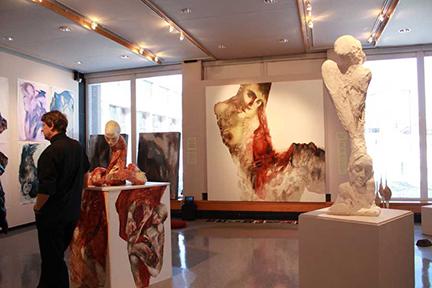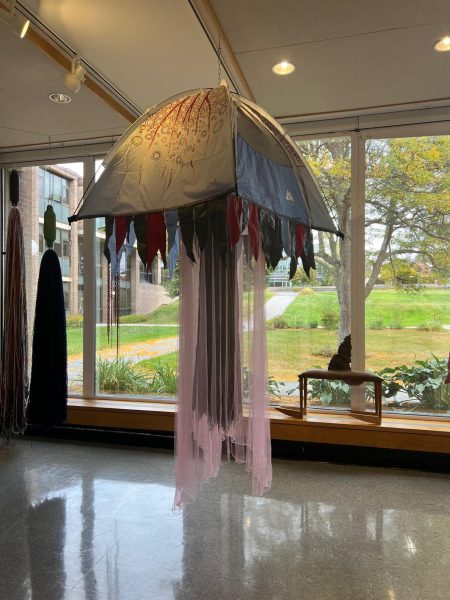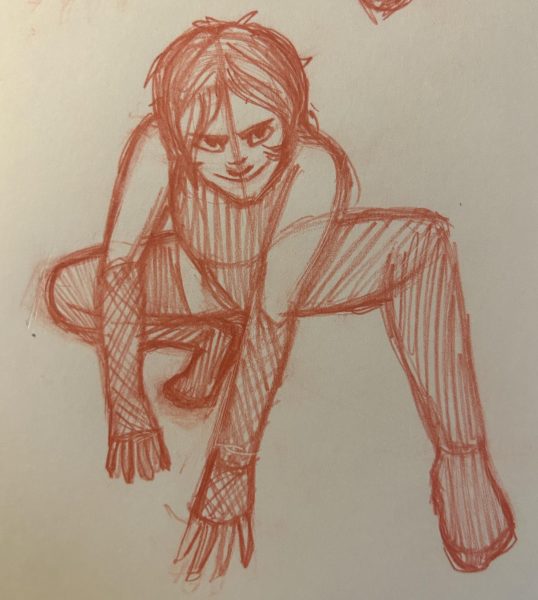Watching you, Watching Them: Scott Ketcham brings “Beauty and Darkness” onto Johnson State Campus

Scott Ketcham’s art display at the Julian Scott Memorial Gallery
The female form sprawled, mostly nude, and composed of broad paint strokes of bright color on paper are features that depict Scott Ketcham’s work. These forms are provocative upon first glance. When studying the curved strokes of the brush and placement of bold yellows, reds, blues, and oranges for minutes at a time, a wave of eroticism is liable to wash over you. Ketcham’s online gallery has not been updated in a long while. Johnson State College students were privileged to see his freshest work on display.
On Thursday, Jan. 30, the Massasoit Community College professor of the Fine Arts spoke about his Master of Fine Arts exhibit in the Julian Scott Memorial Gallery. The exhibit, “Beauty and Darkness” ran from Jan. 28 – Feb. 3, beckoning anybody who walked into Dibden to explore this room of graphic, largely female paintings on all four walls.
Sculptures were centered between the four walls with two different pieces parallel to one another on either side of the room. Walking through the gallery door, I couldn’t help noticing the sculpture to my right: entirely devoid of color, a face stretched towards the ceiling, tendons of flesh holding it back. These tendons connected to other identical faces, looking up at the one defiant face. The second sculpture had similar symbolism and shape but a drastically different impact.
The face above all the others was entangled in what Ketcham said was plaster-soaked burlap. It isn’t stretched towards the Heavens, but stooped over its brethren of identical faces. He chose to use a crude blood – red for this piece, giving an even stronger interpretation of human tissues made more realistic by the burlap’s texture. A grotesque feeling crept into my stomach. To complicate feelings further, the sculpture was perched on top of a box with females painted in the same shade of red on all sides.
A corner of the gallery held more faces huddled on the window sill. A single face, perched on its side, rested on a white rectangular box. Standing in front of this display, I was immediately struck by the three faces suspended from the ceiling encased in giant condoms that hung to the floor – the faces stretching the latex taut around the brow, nose, chin, and jaw line. Looking past these faces, the ghostly white eyes staring at me perched on their side, devoid of expression, came into focus. Ketcham commented on these faces being up for much interpretation, some even finding their expression hopeful like that of angels. I found them haunting, like ghosts that live in darkness, surrounding me in this room.
The other corner of the gallery held two large abstract canvases leaning against the window. Splotches of color on a gray background matched that of the figure paintings: mostly greys, blacks, whites, browns, and some pastels dominated the show’s color palette although not a soul can forget that red. This singular corner is the only place I could look in the entire gallery and not see female form, with a face protruding from the stomach, groin, neck, or face on large sheets of translucent paper. I welcomed this respite where my brain didn’t feel the need to ask the question, “What exactly is going on here?”
Ketcham spoke for about 30 minutes, trying to get the crowd to relate to what he was saying as completely as possible. I didn’t particularly care for the repetitive nature of his presentation, but I loved his humility and the attempt at clarity. With salt and pepper mid-length hair, wearing a black vest over a common black long sleeve shirt with the sleeves rolled up, and slacks, he reminded me of my high school art teacher. Not too concerned with appearance or a well-rehearsed presentation, Ketcham spoke instead with the passionate feelings he gets from his work.
To understand his vision the crowd had to ponder a few questions posed by Ketcham: “What is beauty without darkness?” He described the emotion he felt when looking at something beautiful; there is, he said, a darkness present that can’t be understood, a darkness that just draws him closer. In most of his pieces the purest form of beauty, the young mother, is painted mysteriously. Heavily reliant on position, color, and expression, Ketcham does a wonderful job illustrating the uncomfortable feeling darkness conveys when paired with subjects of beauty. He then posed and answered a second question: “Why are we drawn to dangerous places?” He answered, “Because they’re beautiful. It’s a seduction.”
He feels darkness gives art the vulnerability it needs to be felt most passionately. He intended to use darkness to illustrate what he felt was the modern tendency not to talk about the erotic pleasures of life in a public setting.
This Master of Fine Arts project allowed him to pay less attention to the logic of perfection, just as we should “surrender” our logic to the eroticism inspired by the beauty and darkness that cannot be ignored when viewing each piece of Ketcham’s exhibit.







